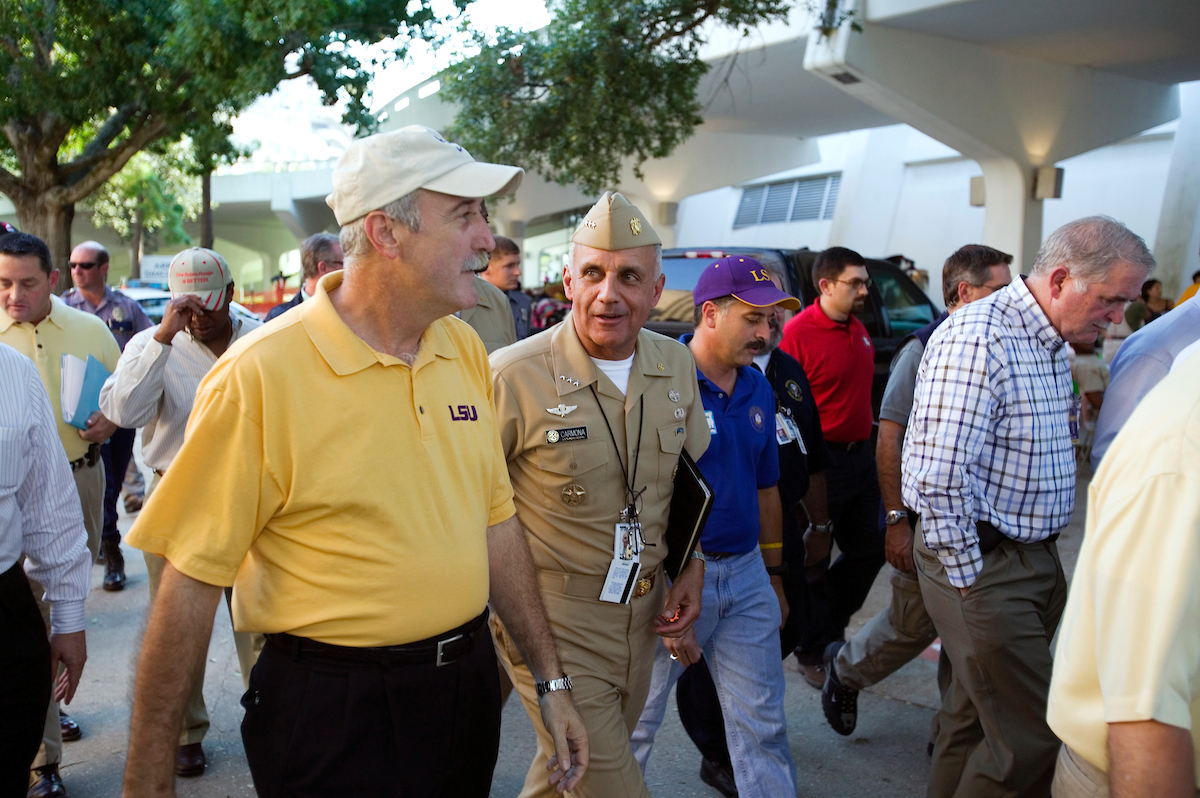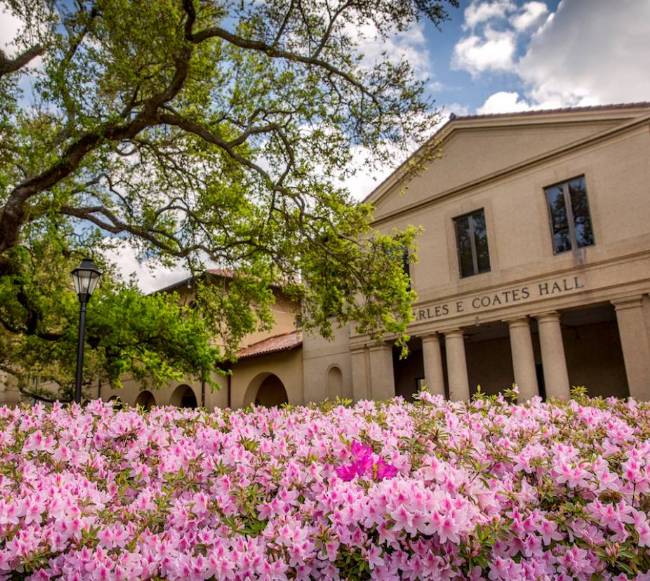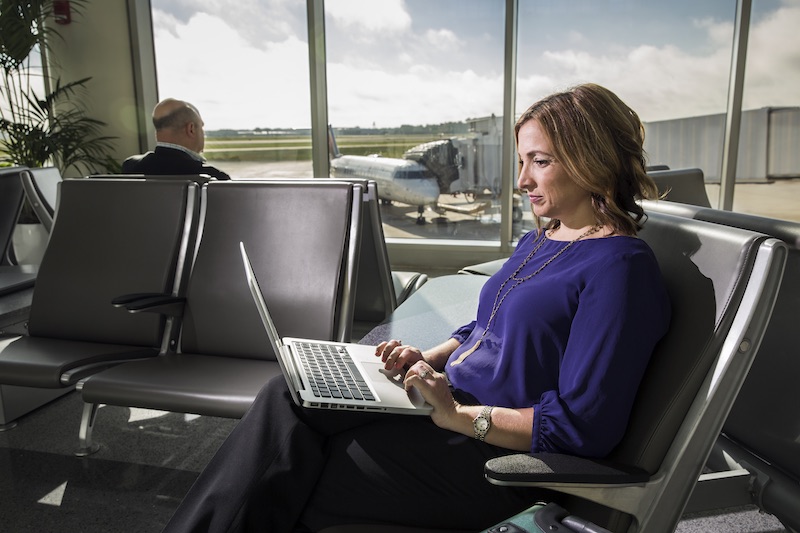Former Chancellor: How LSU Overcame the Chaos to Become a Beacon of Hope in Katrina’s Aftermath
August 07, 2025
The chancellor of LSU in 2005, who led the university’s response after Hurricane Katrina hit Louisiana, calls the massive effort one of the community’s finest moments, when people of all stripes pitched in and the objective became the common good.
Sean O’Keefe, the former secretary of the Navy and former NASA administrator, worked with a team of LSU faculty, staff, and students to turn LSU’s Pete Maravich Assembly Center and Carl Maddox Field House into the largest acute-care hospital in U.S. history.

LSU Chancellor Sean O’Keefe and U.S. Surgeon General Vice Admiral Richard H. Carmona walk outside the Pete Maravich Assembly Center prior to the surgeon general’s tour of the facility on Sept. 4, 2005.
– LSU file photo
O’Keefe agreed to answer questions about the relief effort at LSU. Some responses have been lightly edited for style, clarity, and conciseness.
As chancellor during Hurricane Katrina, how did you and your leadership team mobilize LSU in those first critical days?
I don't think anyone believed or could have imagined that Katrina would result in a diaspora from New Orleans and the southeast coastal area. I remember conducting a meeting a few weeks before, just to get familiarized with our emergency response plan. The meeting covered basic risk management questions. What is our strategy to prepare for a hurricane? How do we deal with the resulting challenge? If need be, where do we send students to evacuate? Who are the people we need to coordinate with? That meeting didn’t answer all the questions, but it got us all thinking about the probable disruption if a hurricane arrived. Just that small dose of risk management planning was enough to put us in the right frame of mind when Katrina landed on us just a few weeks later.
The day after the storm had passed, the diaspora from New Orleans occurred. Most of those evacuating were going north and west, and all roads passed through Baton Rouge. All the power was out everywhere, except at LSU, where we had a cogeneration facility that supplied about half the power the campus consumed. It was a self-contained energy capacity at the university that wasn't affected when the public utilities failed. We were still able to generate power, turn on lights, and do most things necessary to remain operational.
What do you remember most about how the campus community responded?
While the planning exercise was good preparation for University leadership for the reality that LSU had a specific role in a hurricane evacuation plan, no one could have imagined the scale of that involvement for a storm the size of Katrina. All the hospitals in the region were closing, so immediately the thought was, "The state emergency services planning model called for LSU to receive 50 residents from nursing homes. Instead, Katrina affected hundreds of folks in independent living facilities and nursing homes in southeast Louisiana. How many folks might the state be thinking about sending to LSU?" And it quickly became apparent that there may be a lot more expected from LSU than caring for nursing home residents.
“ It was uplifting. It was one of those things that gave you a sense of the reassurance of humans’ capacity to take care of each other in the worst of situations. ”
The day after Katrina passed, legions of starving, dehydrated folks began arriving on campus seeking medical treatment and shelter. Medical professionals from the nearby local hospitals that had closed all volunteered to help. They immediately began to assess what LSU needed to do to prepare for the arrival of many more in desperate need of assistance.
An early decision was made to take up the Parquet floor in the Pete Maravich Athletic Center (PMAC), converting the basketball court, and transforming the facility into a thousand-bed operation, utilizing the auxiliary facilities located behind the PMAC to treat those who needed attention most. The human demand went from zero to a thousand in no time at all. But fortunately, we had the means to scale all this, and LSU had the talent on campus if we could just get organized to use it: University personnel who knew the capacity, community residents, faculty, and students willing to volunteer, and the medical professionals to staff it, because now we knew where to start.
The first few days were chaos. Everybody was trying to figure out what to do and where to go around the PMAC. To deal with the thousands of people lining up outside the PMAC, looking for help, volunteers were handing out sandwiches and attending to basic needs, while ensuring there was plenty of water for everybody. In short order, the physicians, as well as the medical staff and personnel from the hospitals, figured out how to set up a triage operation. Concurrently, LSU set up an Emergency Operations Center to coordinate activities, supplies, assignment of talent, and sharing awareness of the facts surfacing around campus. Chaos subsided, and priority decision-making took over. It was uplifting. It was one of those things that gave you a sense of the reassurance of humans’ capacity to take care of each other in the worst of situations, regardless of one’s politics, background, or ethnicity. We were all humans affected by the same horrific tragedy.
The hurricane hit at the start of the semester. How did that impact what is typically an exciting time on campus?
“ Every hotel within a couple of hundred miles was already completely booked, and public shelters were filling up fast. Students began making accommodations for families in their rooms at the residence halls. ”
It was like night and day. Students were getting familiar with new dorm rooms, figuring out where new classrooms were, and planning for the first home football game. Then everything shut down.
The immediate crisis also affected families of some students who had to evacuate from New Orleans or the surrounding region and had no place to go. Every hotel within a couple of hundred miles was already completely booked, and public shelters were filling up fast. Students began making accommodations for families in their rooms at the residence halls. The occupancy expansion of the residence halls went from standard configurations to a multiple of five overnight. Everybody moving in, animals, pets, you name it...and everything that comes with that.
It was a change from the festive atmosphere of the beginning of the semester to one of desperation, a condition of trying to cope with this tragedy.
Looking back nearly 20 years later, how did Katrina—and LSU’s response to it—shape you personally and professionally? What lessons from that experience still influence your work today?
As a leadership team, everybody who was involved, from the LSU community: staff and facilities teams to every function you could imagine, transportation, campus police, student services personnel, staff at the dining halls, anybody and everybody who could pitch in did their best.
The Emergency Operations Center organized and assembled a series of meetings and discussions across campus to clarify the tasks ahead to motivate everyone. The public communications team convened regular University community forums to assure folks that, “Yes, we’re going to do our best to take care of everybody, to ensure that we’ve taken care of our students.” Days later, we were taking care of students from multiple other universities who hoped to enroll at LSU since their campuses had closed. The registrar’s staff quickly engaged to process several thousand new students.
A different kind of exciting atmosphere at the semester’s opening was evident. Katrina motivated a lot of folks as a result. A sense that we were all united in the task to restore some normalcy to campus life and around our community served to stabilize the situation and provided a remarkable sense of common purpose. Folks felt like, “Well, wait a minute, I'm not doing this alone. I'm here with many others who are facing the same problems and issues as I am. But at least we're all working together to accomplish something that we couldn’t do on our own.” And that changed the atmosphere, the dynamic, and the sense of challenge that came from this.
How does it feel to be part of an institution like LSU that not only played a vital role in Katrina’s response, but continues to lead in research and planning that could save lives in future disasters?
We were extremely fortunate to have had the means to engage in a task that was larger than ourselves. I couldn’t be prouder of the team at LSU that I had the privilege to serve with.
“ I couldn’t be prouder of the team at LSU that I had the privilege to serve with. ”
The campus community rose up to work through this and make it all come together, not only for ourselves, but for the thousands of people who came through our campus desperately looking for help.
It was spectacular, truly. This experience turned into something that was not just a teachable moment. It became an in-depth research enterprise. The Stephenson Disaster Management Institute at LSU now provides the “lessons learned” from crisis management insight to people across the country, and in some places, across the globe. What we did had a profound impact that came about because people dedicated themselves to doing their best in some of the hardest circumstances.
Why should we commemorate this anniversary, both by looking back and looking to the future?
This was one of the LSU community’s finest moments when it established that the common good was the objective, and if we all pitched in, we could all make this work. One of the most inspiring images in my memory that captures this point occurred in the PMAC. All the activity to care for suffering victims was going on down on the floor, but in the stadium stands and risers, scores of students, faculty, staff, and citizens in our community showed up regularly – be it at 2 o'clock in the afternoon or 2 o'clock in the morning – waiting to volunteer their time and help people in desperate need.
That was a remarkable demonstration of the instinctive sense of responsibility that appeared in our community. That was inspiring. It was something that provided tremendous confidence that, in our most challenging moments, people can really work together and figure out how to make things happen. And nobody needed to ask them.
Folks mobilized because they knew it was the right thing to do, and word just got around. That’s the finest expression of humanity that we could have ever hoped for, and it happened at LSU when it was needed most. For that reason alone, this is a moment that should be taken to reflect and embrace this memory as among our community’s finest hours.
Turning Tragedy into Impact
Explore LSU’s role in response, recovery, resilience, and research following Hurricane Katrina.


